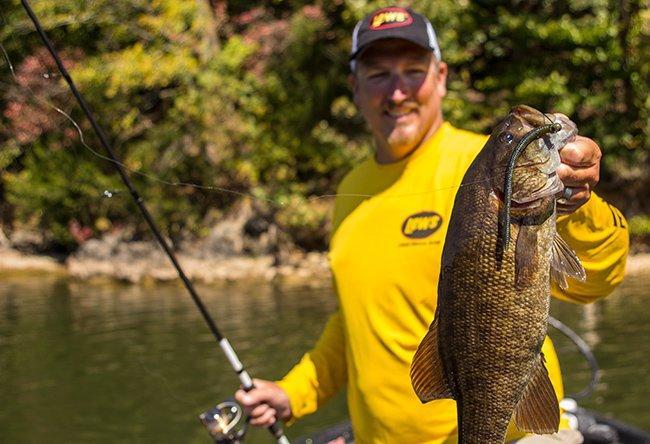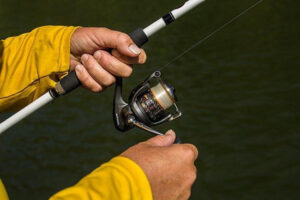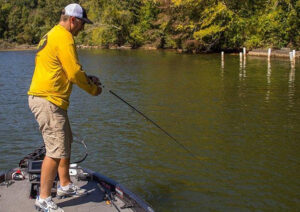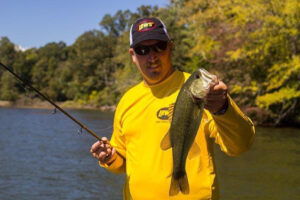It seems as if spinning rods and light line have developed an unfair reputation throughout the bass fishing world. Although many anglers believe finesse fishing to be a “small fish” technique, it’s actually an excellent way to catch numbers of big bass in especially difficult conditions.
Professional fishing guide Jimmy Mason uses finesse techniques to consistently put his clients on giant sacks of largemouth, smallmouth and spotted bass. After decades of instructing anglers of all skill levels, he’s developed 5 very simple tips that will help you become a better and more productive finesse angler.
There’s a time and place for braided line
The use of braided line in finesse applications has become a widely debated topic in the past several years. With little effort, you’ll meet accomplished anglers who swear by it and some who won’t even consider the idea. In Mason’s opinion, both sides have a legitimate point.
“I believe braided line has its place in finesse fishing but it’s important to know the right situations in which to utilize it,” Mason said. “Braid will certainly improve your sensitivity and hooksetting abilities but be careful—it can break your heart when you’re using a super-light fluorocarbon leader.”
Although important, his line selection process is fairly basic and easy to understand. The longer the cast and deeper the water, the more likely he is to use braided main line with a fluorocarbon leader.
- Advantages of braided main line— “Braid has three major advantages when it comes to finesse fishing,” Mason said. “Most importantly, it allows for better hook penetration when you get bit on the end of a long cast because it won’t stretch. It will also dramatically increase your sensitivity when fishing in deep water, which results in more hooksets and fish catches. When you’re fishing in shallow water, it can also help you skip your baits farther and more accurately. It lacks the memory of fluorocarbon, so it comes off the reel smoothly and effortlessly. When I’m using this combination, I use 15-pound Vicious Braid with a 6 to 8-foot Vicious Pro Elite Fluorocarbon leader.”
- Advantages of straight fluorocarbon— “I’m much more likely to use an all-fluorocarbon setup whenever I’m fishing in very clear water because braid is fairly visible to fish,” Mason said. “In this situation, I’ll usually downsize to 6-pound fluorocarbon and if I were to tie that to braided line, the shock of a hookset would cause the fluoro to break.”
Your drag settings are very important
When using casting gear and heavier line, it’s not at all uncommon for anglers to cinch-down their drag for every application. Finesse fishing and spinning gear is much different, however. Because a very small-diameter piece of line is all that separates you from the fish, it’s always smart to pay close and constant attention to your drag settings.
- A few clicks are okay— “I don’t like my drag slipping too much during the hookset,” Mason said. “If your reel is screaming every time you pull back, you’re robbing yourself of a lot of power. I want it to stay pretty firm to facilitate solid hook penetration, so I’m listening for just a few drag clicks on my initial hookset. In my opinion, this gives me the perfect balance of power and shock absorption.”
- Make adjustments during the fight— “I see a lot of anglers who are afraid to manipulate the drag in the middle of a fight,” Mason said. “But that’s when it’s most important. Even though the drag on my Lew’s Team Gold Carbon Spinning Reel is incredibly smooth, you’ll see me constantly stripping drag with my reel hand throughout the fight. Finesse gear gives you an excellent feel for the bass’ movement so use it to your advantage— when it surges, give him some line to keep that hook buried.”
Keep your rod selection simple
Many fishermen—myself included—love collecting fishing gear. It’s a harmless hobby but it can complicate your tackle selection if you’re not careful. Instead of using numerous spinning rods for his finesse needs, Mason uses a simple two-rod system that drastically simplifies his decision making.
“If I’m fishing with braided main line and a fluorocarbon leader, I like to use a medium-action rod with a limber tip in order to absorb some of the extra shock created by the braid.” Mason said. “So whenever my clients and I are using drop shots, small crankbaits and jerkbaits, I’ll go with a 7-foot, medium-action Lew’s Custom Speed Stick Magnum Spinning Rod.”
When the presentation requires a firm hookset, he reaches for a heavier-action rod in order to improve hook penetration.
“I prefer a stiffer spinning rod than most people,” Mason said. “I feel like it gives me more control over the fish and a better opportunity to counter any powerful, boatside surges. If I’m using shaky heads, finesse jigs or soft jerkbaits—anything that requires a hookset—I’ll rig it on a 7-foot, medium-heavy Lew’s Custom Speed Stick Magnum Spinning Rod. It’s important to have a rod with a fast tip action that quickly transfers to a powerful butt section.”
Kick it down a few notches
There’s nothing better than feeling a giant “thump” on the end of your line, executing a monstrous hookset and hearing your line cut across the water’s surface. It’s important, however, to kick it down a few notches when you’re using finesse gear. According to Mason, an overly aggressive hookset is one of the biggest mistakes you can make with light tackle.
“It’s can be hard to discipline yourself when it comes to a finesse hookset,” Mason said. “Our instinct is to come off the floor and crack ’em as hard as we can, but light line isn’t made to withstand such a jarring impact. When you get a bite, simply tighten up the line and pull back. The more slack you introduce into your line, the more likely you are to snap your line.”
Take your time during the fight
Just as we discussed with the hooksets, make a concerted effort to slow yourself down when wrestling a big bass to the boat on light tackle. You’re not using a big broom stick and 65-pound braid, so it’s imperative to relinquish some control to the fish before forcing the issue.
- Use your body to your advantage— “You’ll see a lot of professional anglers running around their boat when fighting bass on light line,” Mason said. “It’s not for show, but rather to tire the fish without applying too much pressure. Don’t be afraid to move around— walk ’em around any obstacles like the trolling motor, outboard motor and Power-Poles. If you see they’re barely hooked, it’s essential to baby them. They’ll wear themselves down if you’re patient.”
- Beware of the boat flip— “It can be easy, especially in a tournament situation, to get rushed and try to flip a bass before it’s ready,” Mason said. “I will boat flip fish up to 3 pounds on finesse gear, but momentum is everything. If they’re rushing towards the boat, you can use that momentum to decrease their weight. If they’re constantly surging like smallmouth often do, I’ll usually get in the driver’s seat of my Phoenix and belly land them.”
- Go with the flow— “Whatever direction a bass moves during the fight, you need to move with it,” Mason said. “If it surges, follow it by extending your arms and putting your rod tip closer to the water. Don’t try to make the fish swim a certain way.”
Whether the action becomes slow due to a nasty weather front or fishing pressure, it’s bound to happen several times throughout the year. If you put away the heavy tackle in favor of finesse gear, however, these tips will help you continue catching fish when other anglers struggle.















